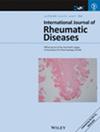Application of a Growth-Rate Model to Enhance Subgroup Identification in Heterogeneous Clinical Courses of the Idiopathic Inflammatory Myopathy-Associated Interstitial Lung Disease and Its Prognostic Implication
Abstract
Background
Analyzing longitudinal real-world data with nonuniform study-time intervals is challenging. This study aimed to identify subgroups in heterogeneous clinical courses of idiopathic inflammatory myopathies-associated interstitial lung disease (IIM-ILD) using a growth rate model and to assess their prognostic significance.
Methods
In this retrospective cohort study, 243 chest high-resolution computed tomography (HRCT) scans from 80 patients with IIM-ILD were analyzed using a computer-aided quantification system to estimate quantitative lung fibrosis (QLF) scores. Longitudinal patterns were identified through a growth-rate model, and a landmark survival analysis was performed using the last HRCT date as an anchor.
Results
Using the growth-rate model, we identified five different patterns in the serial QLF scores: progressive (n = 19), improving (n = 20), convex (n = 10), others (mostly concave, n = 22), and stable (n = 9). When the group with the progressive pattern was divided into the rapid progression and slow progression by the median progression rate (g = 1.029%/month), the rapid progressive group was significantly associated with mortality (Hazard ratio 15.926, 95% confidence interval 1.079–548.324, p = 0.043), compared to the reference group. However, the intensity of immunosuppression or QLF scores at landmark time were not associated with mortality.
Conclusion
Combined volumetric measurement of lung fibrosis and application of growth-rate model had the potential to identify subgroups in analyzing complex, dynamic real-world data of IIMs-ILD. This approach may help extrapolate the future course and provide useful information about prognosis in patients with ILD.

 求助内容:
求助内容: 应助结果提醒方式:
应助结果提醒方式:


